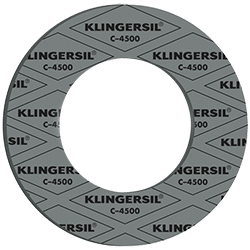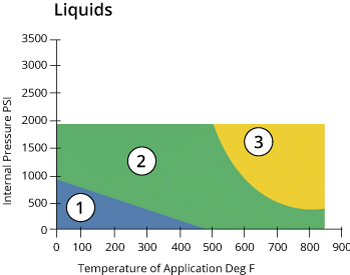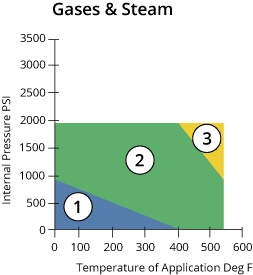
Klingersil C-4500
- Carbon Fiber
- Nitrile Binder
- High Temperature
- High Internal Pressure
- Good Steam Sheet
- Suitable for a Wide Range of Chemical Applications
- Typical values refer to 1/16″ material unless otherwise specified.
Pressure & Temperature Graphs
Material Thickness: 1/16″


The pressure/temperature graphs shown are the most current method of determining the suitability of a gasket material in a known environment. Use the pressure and temperature graphs to select the most suitable material for your application.
- In area one, the gasket material is suitable using common installation practices subject to chemical compatibility.
- In area two, appropriate measures are necessary for installation of the gasket to ensure maximum performance. Please call or refer to the KLINGER® expert software system for assistance.
- In area three, do not install gaskets in these applications without first referring to the KLINGER® expert software system or contacting DD Engineered Product Inc.’s technical support service. These graphs were developed from testing Klinger materials. Do not use them for competitors’ materials since non-asbestos gasketing materials do not have service equivalents.
Use: The limitations of use, as shown in the graphs, are for guidance only, and are based on 1/16″ thick material. The limitations of use decrease significantly as gasket thickness increases. Do not use a thicker gasket material or “double gaskets” to solve a gaske t problem without first consulting the manufacturer. The ability of a gasket material to make and maintain a seal depends not only on the quality of the gasket material, but also on medium being sealed, the flange design, the amount of pressure applied to the gasket by the bo lts and how the gasket is assembled into the flanges and tightened.
| Creep Relaxation ASTM F38B (1/32”) | 20% |
| Sealability ASTM F37A (1/32”) | < 0.30 ml/hr |
| Gas Permeability DIN 3535/6 | < 1.0 ml/min |
| Compressibility ASTM F36J | 12% |
| Recovery ASTM F36J | 60% minimum |
| Klinger Hot Compression Test Thickness Decrease 73°F (23°C) Thickness Decrease 572°F (300°C) | . 10 % initial 15% additional |
| Weight Increase ASTM F146 after immersion in Fuel B 5h/73°F (23°C) | . . 10% maximum |
| Thickness Increase ASTM F146 after immersion in ASTM Oil 1, 5h/300°F (149°C) ASTM Oil IRM903, 5h/300°F (149°C) ASTM Fuel A, 5h/73°F (23°C) ASTM Fuel B, 5h/73°F (23°C) | . . 0-5% 0-3% 0-5% 0-5% |
| Dielectric Strength ASTM D149-95a | . 1.5kV/mm |
| ASTM F104 Line Call Out | F712122B3E11K6M5 |
| Leachable Chloride Content FSA Method (Typical) | . 200 ppm |
| Density ASTM F1315 | 87 lb/ft3 (1.4 g/cc) |
| Color (Top/Bottom) | Black |
